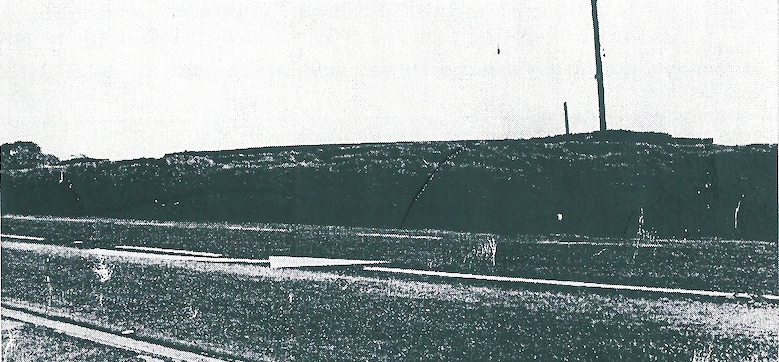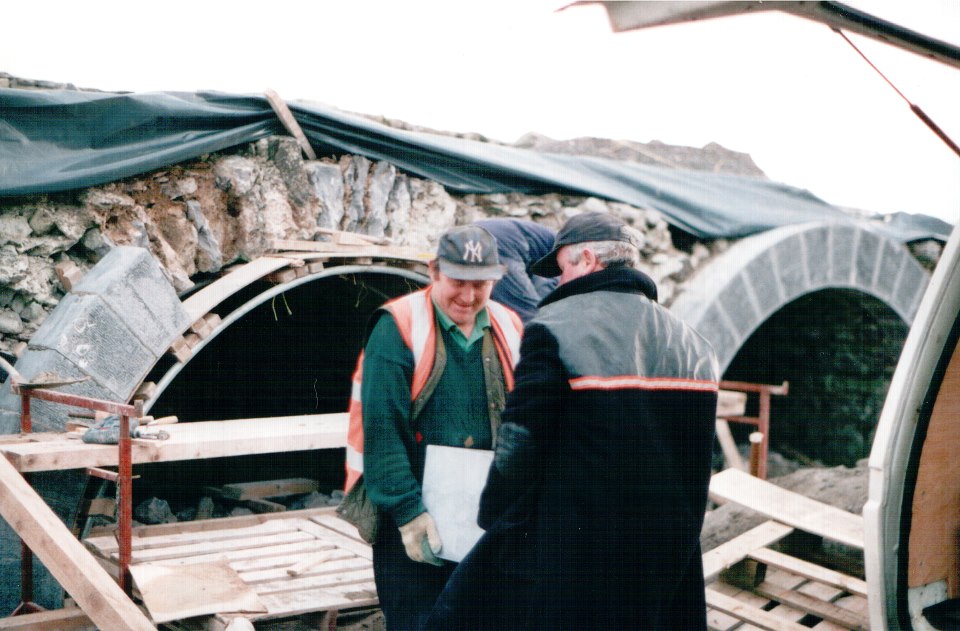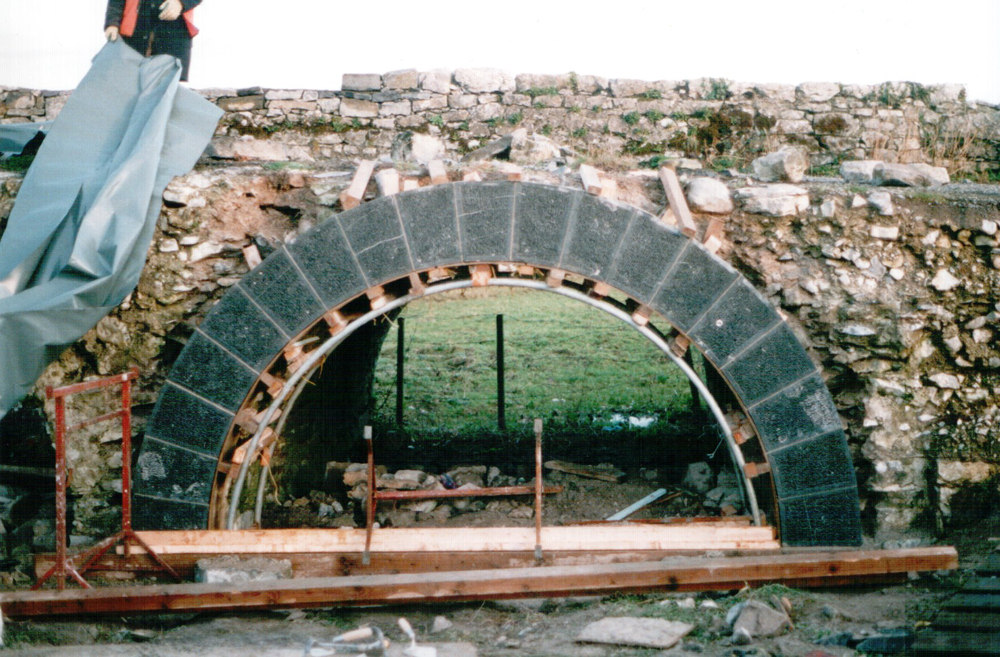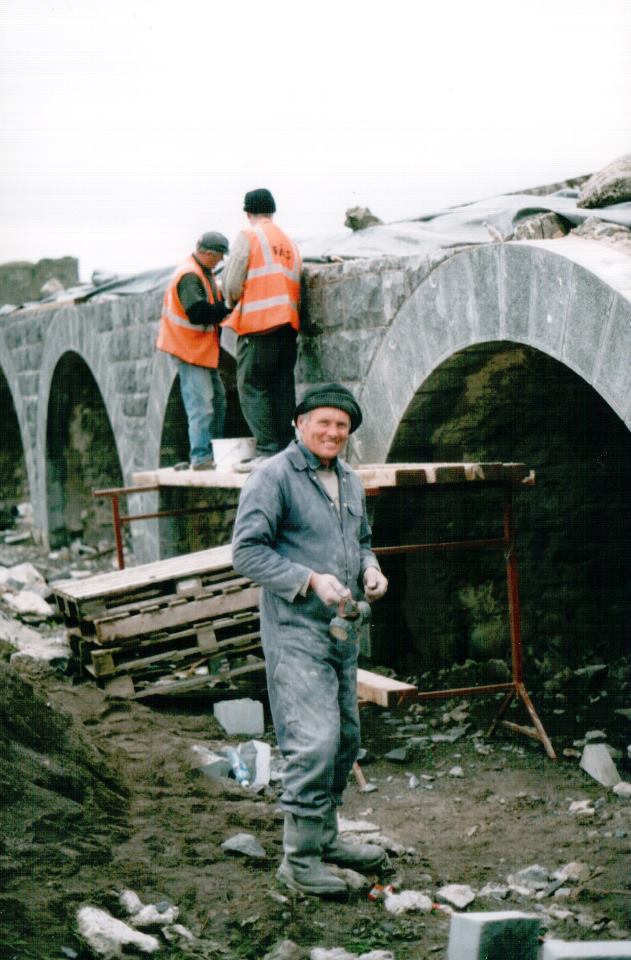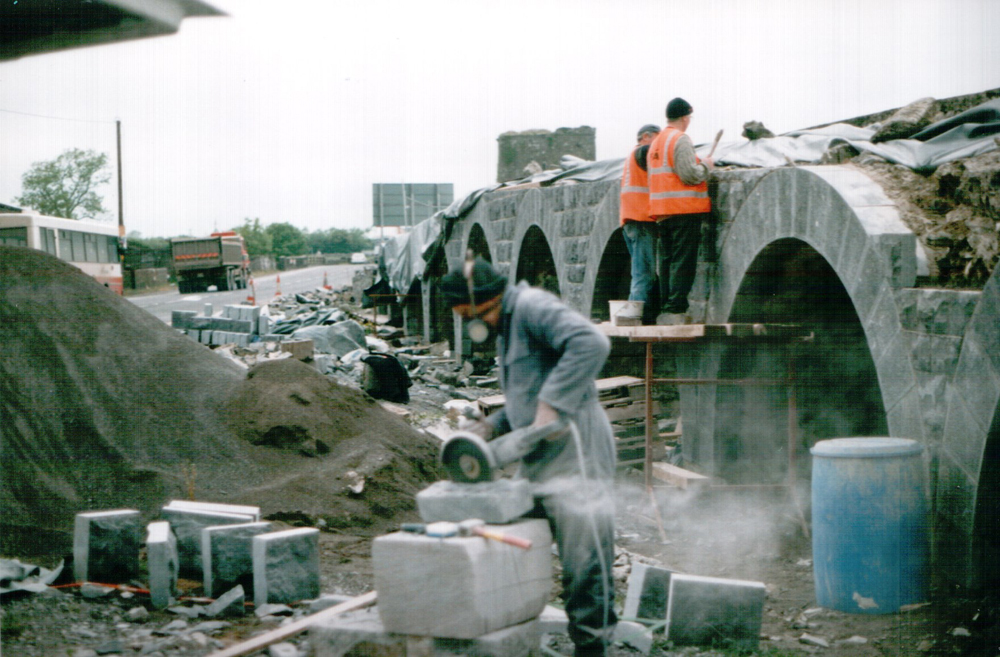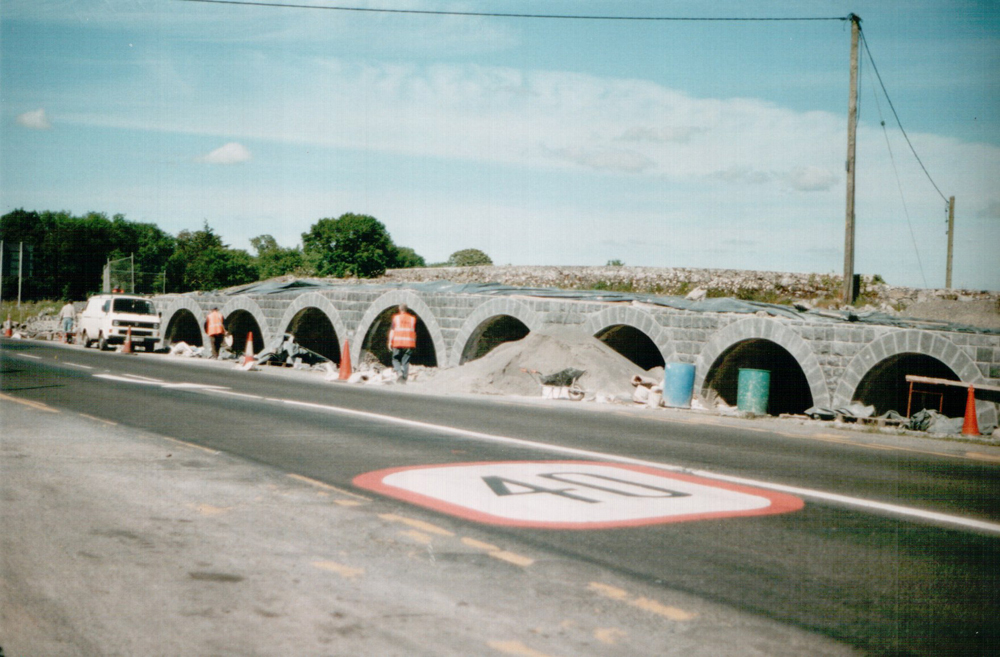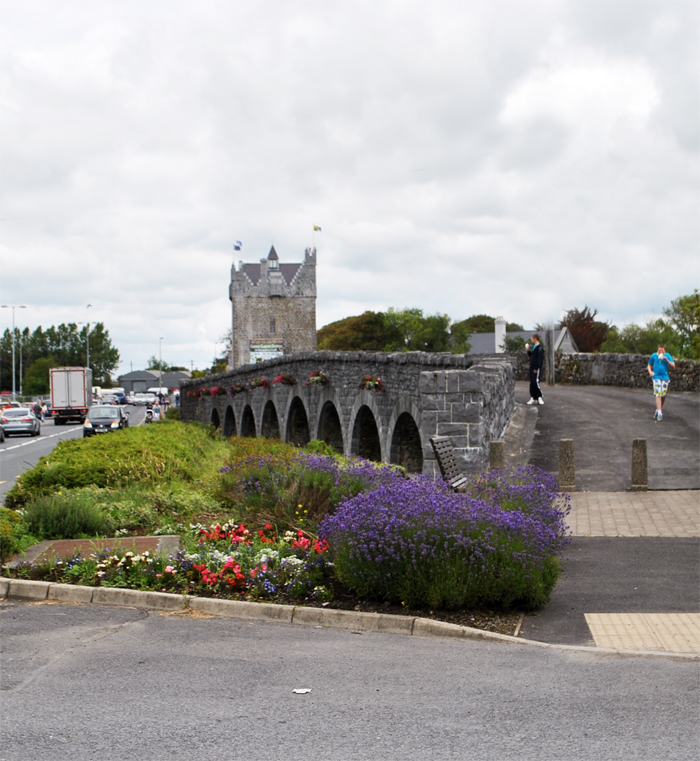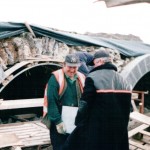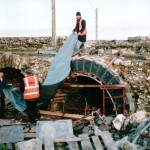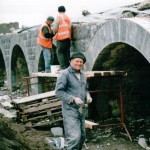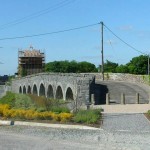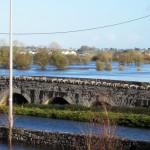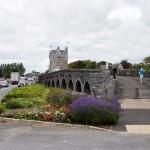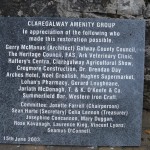Until 1998 the Nine Arches were covered, invisible from the road. For a short period in the eighteenth century they were the bridge over the River Clare on the Galway to Tuam road, but now no water flows beneath them.
The bridge was erected in stone probably in the early 1700s. Cut and dressed rock from a local quarry would have been used by skilled stone masons, cutters and probably a large number of men to give the facing stones the splendid finish and all of this was done by hand! They would have mixed mortar of local sand, water and lump lime (made by burning limestone in a local kiln).
The Arches were short-lived however, as in 1765, shortly after their construction, John Borkin, a local landlord from nearby Lackagh, changed the course of the river—diverting it away from under the Nine Arches to a deeper channel about 30 metres further north. His plan was to improve the drainage in the area and to make the river navigable to Tuam, but this was thwarted by unbreakable rock in Lackagh. There are two old stone plaques set in the wall on either side of the north end of the bridge that commemorate the work by Borkin. These stones were taken from the original bridge that stood there.
It is also believed that some eighty to ninety people from the Tuam and Corofin area died during the Gorta Mór in 1847 underneath the old Nine Arches Bridge at Claregalway. There were no coffins at that time and people were buried with mats of straw as coffins.
The present bridge was constructed in 1957, (extended in 2012 as part of flood alleviation works) and replaced the previous narrow bridge. The main road was also widened at that time and the front of the Nine Arches Bridge was destroyed in the process and covered in debris. Up to that time, the Galway to Tuam road passed over the Nine Arches. Claregalway Amenity Group initiated the restoration of the Nine Arches in 1997 and it was successfully completed in 2002. This involved:
- Removing the spoil from in front of the bridge
- Re-facing with cut stone on the road side of the bridge, using the traditional lime mortar
- Erecting protecting pillars
- Erecting night spot lights
- Performing other landscaping work
Original proposal
This extract is from a report on Claregalway Amenity Group from the October 1997 Nuacht Chláir:
Our next and most ambitious project is the development of the Nine Arches in Claregalway. The deepening of the River Clare rendered the old bridge redundant. The road was subsequently realigned and lowered by Galway County Council, but the stone arches of the old bridge are still in place. Our proposal would involve the removal of the debris on the eastern side of the N17 (opposite the Nine Arches pub) and the stone arches could be exposed. The western side of the bridge was either damaged or unnecessarily removed at the time of the road works. The Arches would be rebuilt at this location and the surrounding areas would be suitably landscaped. An information plaque would be erected outlining the origin of the Arches, and the subsequent developments which have rendered them redundant.
As you can imagine, this will be a major task and painstaking. We welcome any ideas you, the Community, have in realising this project. At time of print, we are negotiating with Galway County Council with regard to carrying out this project. The Council have been most helpful with all our projects and we hope to continue our positive liaison with them.
Phases
The following is extracted from an article in the Nuacht Chláir in February 1998:
Phase I has been completed in conjunction with Galway County Council. This involved the clearing of the Arches. With money allocated from Councillors notice of motion funds we were able to complete this phase. We thank Senator Jarlath McDonagh, Councillors Paddy McHugh, Deputy Padraic McCormack for their prompt response for funds towards this project.
Phase II involves the restoration of the Nine Arches in which the FÁS workers will be specially trained in restoring the stonework under the aegis of supervisor Tom Cullinane. Councillor Seamus Gavin has confirmed he will allocate notice of motion funds towards this phase. His gesture is much appreciated. Phase II will be a time consuming and expensive process. We are currently finalising costs in this regard in liaison with our local architect Geri McManus to whom we are deeply indebted for her commitment and expertise. A sincere thank you to Area Engineer Diarmuid Croghan who helped us get this project initiated. His co-operation and commitment is deeply appreciated. Thank you to Colm Wallace of Galway County Council who is a constant source of inspiration to us, to Sean Connell, Area Foreman, thank you for your continuous help on the ground. Our Group are very enthusiastic about this project and look forward to having this historical structure back to where it belongs—within its monastic setting.
During their five year restoration, the Nine Arches were slowly unveiled to passers-by as FÁS workers refaced each arch, a reward for the extra time spent waiting in traffic. Local resident Patricia Carton wrote the following poem in January 1998:
The Return
Red and white cones
Yellow diggers.Roadworks.
What’s the story?Major clearance
Reappearance.The Nine Arches
In all their glory.
Restoration effort
This report from November 1998 by local Architect Geri McManus explains how the Arches came to be restored:
The restoration of the Nine Arches early 18th century bridge at Claregalway was commenced by Claregalway Amenity Group at the beginning of this year. In order to appreciate the nature of the task undertaken, one must think back to c.1700 when the bridge was being built.
At that time, probably quite a large group of men, including skilled stone masons and stone cutters, would have been working on the job. By hand they would have cut and dressed rock from the local quarry to the shapes they required, giving the facing stones the finest finish with the narrowest joints between them (about ⅛ inch). They would have mixed mortar of local sand, water and lump lime (made by burning local limestone in a local kiln). Their work has lasted almost three centuries, with the finely cut stone of the east and back side still to be seen.
Misfortune befell the west and front face c.1950 and left it without its facing stone, but today, as part of the Claregalway Amenity Group project, work is under way to restore it. The work is being done, not by many skilled stone workers, but by a group of FÁS with only one, albeit excellent, stone mason as a trainer.
The best conservation practice follows the principle ‘repair like with like’ as closely as possible. With this in mind at the beginning of the year, the members of the Claregalway Amenity Group went forth in good spirits to find great lumps of stone ready-cut and dressed to suit their purpose since the 18th and 19th centuries, but such was not to be found. After much deliberation it was accepted that newly quarried, sawn stone, surface finished similar to the original by a skilled stone cutter, would have to be accepted.
This was obtained and the results are to be seen in the form of 3 newly erected Arches at Claregalway. The mortar used consists of lump lime, sand and water as did the original, the lime coming from a kiln in Co. Down where a conservation enthusiast is doing things the old way. The joints are 4mm wide as are those to be seen on the east face of the bridge—a width unheard of in modern-day brick and blockwork.
The FÁS workers and solitary stone mason are rightly proud and deserve continued support until the completion of the project in 1999 when the bridge will be returned to its full splendour.
Progress Report December 2000
Work on the bridge has been proceeding steadily all year. The facing of the two wings on either side of the Arches and end piers were completed by the stone mason, Paddy Quinn, with FÁS workers assisting. This was done using cut stonework in keeping with the east face of the bridge and pure lime/sand mortar as would have been used historically. This work looks well and the use of the old techniques have been successful. Though easy to work with the lime/sand mortar requires greater care in use and much more protection afterwards than cement/sand work. The success of the work on the bridge is a tribute to Paddy and his team.
The guard wall above the Arches was built by the FÁS team using rubble stonework brought to courses, faced both sides, with rubble centre and cement/lime/sand mortar. It was decided to show no mortar on the face. The wall is capped with large stones spanning the width of the wall in the traditional manner (see the earliest part of guard wall on east side). This work took care and attention to detail and the team again made a great job.
A drainage channel was dug at the back of the guard wall to prevent water draining through the wall and down the face of the bridge. Work is now proceeding with the construction of steps on the north side of the bridge and then the hard landscaping below the Arches will be done. It is hoped to flood light the Arches from the ground, and install some decorative lighting at street level. Iron railings and other decorative street furniture will be required for pedestrian safety and to stop vehicles entering onto or under the bridge.
Progress Report February 2002
The work on the bridge is nearing completion. In 2001 the team concentrated on works to the ground surface and hard landscaping. The cut stone steps at the north end of the bridge were completed and look very well. Repairs were made to the triangular cut stone breakwaters on the east face of the bridge. These repairs were done prior to the finishing of the ground surface, and though much of the work is now covered up, it was correct to do the repairs in stone, as, in the future, they may be exposed again as part of a more ambitious landscaping scheme.
The treatment of the ground surface was kept very simple, due to cost restraints and some concerns of Galway Co. Council about safety. The finished surface is stone chips, and the differences in level are accommodated using gentle slopes. However, although the original plans for steps between a low level under the middle Arches and a higher level at the sides had to be abandoned, nevertheless, consideration was given to how the ground should slope, and the stone work at the base of the Arches has not been obscured.
- The provision of recessed flood lights at ground level by Galway Co. Council is very successful. The highlighting they provide at night is very attractive.
- Bollards have been placed along the front of the Arches by the Co. Council to stop traffic encroaching on the area. A low stone wall was originally planned for but unfortunately cost was again a factor.
- The street furniture, seats and a bin which are now in place enhance the area, and protective railings and handrails are planned at the steps. Western Ironcraft are looking at the design for these at the moment.
- As the project nears completion, the several FÁS teams and many others who were involved in the project are due congratulations.
Official opening
The wonderfully restored Nine Arches bridge was officially opened on Sunday, 16th June 2003. The weather did its bit by providing a beautiful day, which this fine renovation deserved. The opening was by Eamon Ó Cuív TD. Speakers were: Josette Farrell (Chairperson), Gerry McManus (Architect), Marie Mannion (Heritage Officer with Galway Co Co.), Colm Wallace (County Council Engineer), Jarlath McDonagh, (County Councillor), Noel Grealish TD and Mary Hoade (County Councillor). Rev Fr Noel Mullin performed the blessing. Seamus O’Connell acted as Master of Ceremonies for the occasion.
All speakers paid tribute to all those who helped with the restoration and promised support for the future plans of the Amenity Group. There was a large attendance from the parish to witness the opening. The combination of fine weather, attractive flowerpots, bunting that was arranged all around and background accordion music all helped to create a marvellous and friendly atmosphere.
A large number of people and organisations gave tremendous support and assistance in this effort. FÁS workers on Council FÁS scheme provided the labour. Professional advice was voluntary and the management of the project was undertaken by the County Council. Funds were received from the County Council and from local sponsors.
- Before 1998, the Arches were covered in dirt and were invisible from the road. After discovering this, Josette Farrell and the Claregalway Amenity Group initiated a restoration project and the Arches were uncovered.
- In early 1998, FÁS workers uncovered the Arches, and revealed some of Claregalway’s hidden history.
- FÁS workers Josie and Paraic lifting some stone into place.
- Over five years, the Arches were carefully refaced with cut stones.
- Even though the cut stones were new, they were made seem weathered by pouring buttermilk onto the limestone, whitening it in places.
- Stonemason Paddy Quinn.
- A lot of work was done on-site, which resulted in occasional extra traffic delays, but the slowly evolving Arches provided an interesting view from the driver’s seat.
- Though progress was slow, the fresh faced Arches quickly became an important landmark in Claregalway.
- The Arches as they looked in 2005. Note the Castle still under development in the background.
- In November 2009, the worst floods in recorded history struck Claregalway, and water flowed under the Nine Arches for the first time in more than a hundred years.
- The Arches as they looked in 2011. The landscaping was undertaken by Claregalway Tidy Towns committee and the Castle in the background is looking splendid.
- The east face of the Nine Arches today—they were much less damaged than the west face (by the road) and so were not refaced during the restoration.
- A plaque was erected at the Arches in appreciation of local residents who made the restoration possible.


